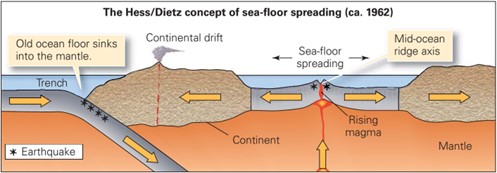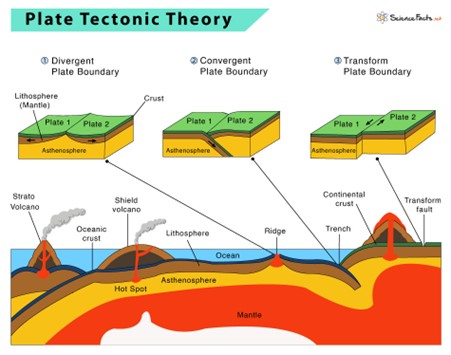-
23 Jan 2024
GS Paper 1
Geography
Day 56: Bring about the basic difference between Continental Drift theory, Sea Floor Spreading theory, and Plate Tectonics theory. (250 words)
- Start the answer by introducing different theories.
- Discuss the differences between the Continental Drift theory and SeaFloor Spreading theory.
- Analyze differences between Sea Floor Spreading theory and Plate Tectonics theory.
- Conclude as per the requirement of keywords.
Introduction
The study of Earth's dynamic processes has led to the development of various theories that explain the movements and changes occurring on its surface. Three prominent theories in this regard are the Continental Drift theory, the Sea Floor Spreading theory, and the Plate Tectonics theory.
Body
Basic Differences Among Continental Drift, Sea-floor Spreading, and Plate Tectonics Theories:
- Continental Drift Theory:
- Proposed by Alfred Wegener in the early 20th century, the Continental Drift theory suggests that the continents were once part of a supercontinent called Pangaea.
- Over time, due to the process of continental drift, these landmasses drifted apart to their current positions. Wegener supported his hypothesis with geological evidence, such as matching fossil and rock formations on continents separated by oceans.
- While the theory faced skepticism initially, it laid the foundation for later developments in plate tectonics.
- Sea-Floor Spreading Theory:
- Building on the Continental Drift theory, the Sea-Floor Spreading theory was developed in the 1960s by Harry Hess.
- This theory proposes that new oceanic crust is formed at mid-ocean ridges through volcanic activity.
- As magma rises from the mantle, it solidifies, creating new oceanic crust that pushes the existing crust away on either side of the ridge.
- This process results in the widening of ocean basins and provides a mechanism for the movement of tectonic plates.
- Plate Tectonics Theory:
- Proposed by Tuzo Wilson, it is a comprehensive theory that encompasses both Continental Drift and Sea-Floor Spreading.
- It was developed in the late 20th century, combining various geological concepts into a unified framework.
- According to this theory, the Earth's lithosphere is divided into several rigid plates that float on the semi-fluid asthenosphere beneath.
- These plates interact at their boundaries, which can be convergent, divergent, or transform.
- Convergent boundaries involve plates colliding, divergent boundaries involve plates moving apart, and transform boundaries involve plates sliding past each other.
- Plate Tectonics provides a broader understanding of the dynamic processes shaping the Earth's crust and explains phenomena such as earthquakes, volcanic activity, and the formation of mountain ranges.
Conclusion
The Continental Drift theory, Sea Floor Spreading theory, and Plate Tectonics theory represent significant milestones in our understanding of Earth's dynamic processes. The evolution from Continental Drift to Plate Tectonics signifies the continuous refinement of scientific knowledge in the field of geology.







